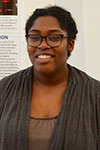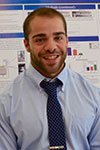Two Awad Lab graduate students, Bentley Hunt and David Abplanap, were selected to receive a CMSR Symposium Distinguished Abstract Award this year. This new award recognizes outstanding abstracts that were submitted for the 2016 poster session. Below are the winning abstracts for both students.

Bentley Hunt
Critical-sized bone defects are the result of tumor resection or severe injury and require surgical intervention to regenerate the bone and salvage the limb. The current "gold standard" to treat critical-sized defects is cadaveric allografts; however, these grafts have a 25% failure rate due to fibrotic non-unions and post-surgery fractures and if successful, the grafts only have a 5-10 year lifespan. These limitations have been attributed to the absence of an osteoinductive component and slow remodeling of the graft in vivo. The optimal standard of healing is an autograft due to the presence of the periosteum. This cortical bone lining tissue contains a depot of stem cells, osteoprogenitors, and a vascular network that act as the origin of angiogenesis and osteogenesis after fracture. It has been shown that live autografts without a periosteum result in a 10-fold decrease in neovascularization and 73% reduction in new bone formation compared to a complete autograft. Therefore, we hypothesize the delivery of a vascularized periosteum biomimetic will improve the regeneration of critical-sized bone defects. We have previously demonstrated the feasibility of delivering mesenchymal stem cell (MSC) sheets to treat a critical-sized mouse femoral defect, which enhanced osteogenesis of a devitalized allograft during repair. The objective of this study was to determine the feasibility and culture conditions for in vitro vascularization of a MSC sheet. We hypothesize that co-culturing MSCs and endothelial cells (ECs) in vitro can produce a premature vessel network within the MSC sheet to act as an origin of angiogenesis when implanted in vivo. MSCs and ECs were co-cultured for 5 days or 4 weeks while varying the percent O2 [5% & 21%], the percent ECs in co-culture [25%- 40%], and the seeding strategy [mixed, concurrent and lamellar]. After 5 days in culture, network formation could be seen in cultures under 21% O2, but there was limited network formation at 5% O2 while EC culture alone was not affected. After 4 weeks in culture, varying the percent endothelial cells from 25% to 40% did not significantly change the quantified capillary density, which was ~100 cm-1. A concurrent, mixed seeding strategy resulted in an increased capillary density and more branched morphology of the formed network as compared to a lamellar seeding strategy. Texas Red dextran staining surrounded by GFP+ expression indicated lumen formation in the co-culture system with lumen diameters ranging from 6 to 13 microns. Mouse derived co-cultures (mACD31+/C3H) produced a significantly increased capillary density compared to human derived co-cultures (HUVEC/hMSC) and surpassed the capillary densities seen in the periosteum of mouse tibia and calvarium. These data indicate that 21% O2, >25% ECs in co-culture, and a mixed seeding strategy produced optimized human and mouse vascularized cell sheets with branching, interconnected structures. These structures also show evidence of lumen formation in vitro. The vascularized mouse cell sheets also produce a capillary density surpassing that seen in the tibia and calvarium. All these factors support feasibility for pre-vascularizing a MSC sheet and its delivery for an early revascularization of critical sized defects. Moving forward, we plan to graft these vascularized cell sheets onto our 3D printed calcium phosphate scaffolds, which will be tested in vivo using an established mouse critical sized calvarial defect model. The current gold standard treatment for large bone defects is devitalized allografts, but allografts have a limited lifespan and often require multiple reconstructive surgeries. Delivery of pre-vascularized stem cell sheets could improve large defect regeneration through early revascularization and osteogenic induction, and ultimately provide a long-lasting surgical option.

David Abplanap
Flexor tendon injuries are some of the most difficult insults to the hands for doctors to treat and restore to natural function. Following reparative surgery, the healing process is fraught with formation of debilitating tendon adhesions as well as increased likelihood of tendon rupture requiring another surgical intervention. Our lab studies the unique biology behind the healing process of the flexor tendon searching for ways in which we can manipulate this biology to achieve a more regenerative healing process. The MRL/MpJ (MRL) mouse strain has been widely studied as a potential mammalian model of regenerative-like healing and has shown promising results in an Achilles tendon defect model but the specific process allowing for this improved healing capacity is still unknown. Additionally, the degree of regenerative healing observed in these mice varies significantly between tissue types as well as methods of injury. We hypothesize that the MRL strain will demonstrate an improved healing response in our flexor tendon injury model, forming smaller adhesions and recovering more native tendon strength. Additionally, we propose that this improved functional outcome is a result of the different immunological response to injury in this strain compared to C57/Bl6 (C57). Age-matched (10 weeks) MRL and C57 mice were subjected to a bi-lateral partial laceration of the deep digital flexor tendon in the middle digit of the hind paws. Hind limbs were harvested for mechanical testing and histology at 2, 4, and 8 weeks following injury (along with Day 0 uninjured controls). Blood serum was extracted at Days 1, 3, 5, 7, and 14 following injury and subjected to inflammatory cytokine/chemokine, MMP, and TGF-β serum analysis panels respectively (along with Day 0 uninjured controls). In examining histology, we can clearly see an enhanced cellular response to injury (higher observed cell density and number) both in the injured tendon as well as surrounding tissue in C57 compared to a more localized response (seemingly tendon tissue specific) in MRL at 2-weeks. This enhanced level of cellularity in C57 is maintained through the 4-week timepoint and remains elevated at the 8-week end point in C57 whereas MRL shows significant reductions in hypercellularity by 4 weeks. At the end of the 8-week time course, MRL appears to exhibit less adhered tissue between tendon and the synovial sheath as well as more complete resolution of the initial insult to the tendon when compared to C57. Examining the blood serum, it appears that the C57 response to injury is more aggressive exhibiting higher up-regulation of hallmark inflammatory cytokines (IL-1, IL-6, IL-17, TNF-α) in both early (D1/D3) and late stages (D14) of the healing response compared to MRL. These results lead us to conclude that the MRL mouse does indeed exhibit a different healing response to flexor tendon injury than C57 and that this response results in an improved biomechanical outcome after injury. It also appears that the specific immune response to injury could in some way be contributing to this improved outcome and that the blunted inflammatory response observed in MRL could target a less fibrotic more regenerative healing pathway when compared to C57. These results motivate further study of the MRL mouse in this injury model to better understand their unique healing pathway while highlighting the inflammatory response as a potential source of the observed differences in healing response and overall quality of repair.